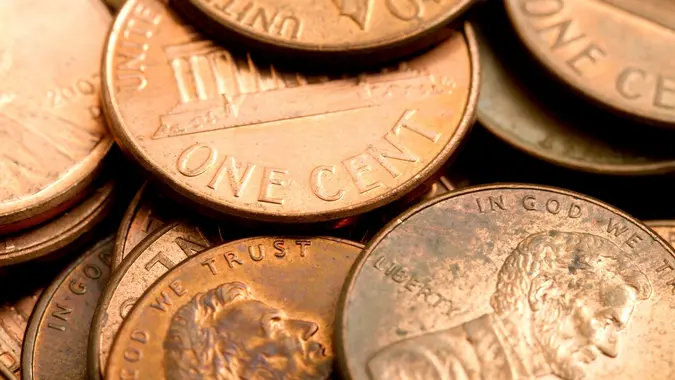7 Tips To Make Your Paycheck Last Longer in 2025

Commitment to Our Readers
GOBankingRates' editorial team is committed to bringing you unbiased reviews and information. We use data-driven methodologies to evaluate financial products and services - our reviews and ratings are not influenced by advertisers. You can read more about our editorial guidelines and our products and services review methodology.

20 Years
Helping You Live Richer

Reviewed
by Experts

Trusted by
Millions of Readers
Does it seem like as soon as your paycheck hits your checking account, you’ve already spent it all? You’re not alone. Many Americans are living paycheck to paycheck and struggling with the increasing cost of living.
Breaking out of a paycheck-to-paycheck cycle can seem difficult, but there are some simple ways to save more and spend less that will make your paycheck last longer — no matter how much you are making. We spoke to financial experts to get their best tips for holding onto more of your paycheck.
Save a Portion of Every Paycheck
To better set yourself up for a stable financial future, you can try breaking your paycheck into percentages, such as with the 50/30/20 rule. This is where you allocate 50% of your paycheck toward necessities such as rent and bills, 30% toward discretionary spending and 20% into savings.
“Pay yourself first,” said Renee Johnson, the editor-in-chief of Techreport. “Instead of paying your expenses first, put a set percentage of each check into your savings account.”
Johnson continued, “Take care of your expenses next — and what you have left over is your fun money. If you don’t do it this way, it’s far too easy to overspend on the fun stuff and not put a lot into savings.”
To ensure you actually follow through with this, consider setting up an automatic transfer from your checking to your savings or retirement account every pay period.
Find Other Sources for Your Savings
Come up with a savings rule for yourself to ensure that you are regularly contributing money to your savings whenever possible. You can automatically transfer funds from your paycheck or make it a fun family money-saving challenge.
Bobbi Rebell, a certified financial planner (CFP) and the founder of Financial Wellness Strategies, offered the following examples:
“Every time you get a coupon that you use for a purchase, move that amount of money into savings. Or any time someone pays you back via Venmo, put that into savings. Or every time you get cash change under $5, put that into a savings jar at home and then deposit once a month. You get the idea.”
Track Your Spending
“We all need to live within our means, but it’s often far too easy to lose track of what exactly our spending parameters are,” said Meredith Stoddard, the former group team lead at Fidelity Investments.
“Even if you think you’re living well within your paycheck, it can be helpful to periodically step back and review where you actually stand.”
Stoddard said the first step is finding out exactly where all of your money is going.
“Even simply tracking what you are spending over a short period of time — say, by taking a look at one month’s worth of bank statements and bills — can give you a good sense of where your money goes,” she said. “You can’t fix what you can’t see.”
Stoddard said to be especially aware of any recurring payments.
“Recurring payments and subscriptions are a great way to automate your life, but it can be easy to forget they’re there if you’re not paying attention,” she said.
“Make sure you know what you’re paying for and that you’re actually using what you’re paying for. If you’re paying a monthly fee for something you really haven’t used in months, it might be time to free up that cash for other uses.”
If you have multiple subscriptions for the same type of service, consider canceling the ones that you don’t use as often.
“Look for ways to scale back,” said Elena Ochian, senior director of work & rewards at WTW, a multinational business consulting firm. “Is it really worth it to you to have multiple streaming services at the same time?
“Also, if you tend to overspend in one category, like eating out, try giving yourself an allowance for that category every month to reduce expenses. Consider the amount saved as a mini pay raise and apply it right away toward your goals.”
Try To Lower Your Essential Expenses
“Shop around — insurance, cellular, wireless and the internet often have options,” Stoddard said. “Check out the competition and also take a look at the plans your existing providers offer to determine whether there are more economical alternatives that fit your needs just as effectively. The savings can add up.”
While it may be more convenient to comparison shop online, sometimes a phone call can be worth the extra effort.
“There’s a very good chance you could be paying far less, and oftentimes it just takes a phone call to find out,” said Jim Wang, founder of WalletHacks.com. “If the service refuses to budge when you ask, threatening to cancel can often lead to big savings because they want to keep you as a customer.”
According to Wang, satellite radio is a prime example.
“Many folks are not driving as much for work and so canceling that service could be a great way to save money. The standard rate for satellite radio is around $20 to $30 a month; but, if you threaten to cancel, you can often get it for $25 every six months.
“That’s a significant savings most people don’t know about, but I’ve heard from over a hundred readers that have done it successfully.”
Think Twice Before Throwing Something Out
Being thrifty and frugal doesn’t mean you go without; it’s more about appreciating what you already have. This appreciation leads to wiser decisions when it comes to spending.
“Extend the life of what you already have — reusing, repairing and using things longer can add up to a lot of savings over time,” Stoddard said. “Bonus: There’s a great benefit to the environment too!”
Be Mindful Before Making a Nonessential Purchase
“Spending money is a mindset,” said Jason Hennessey, the founder and CEO of Hennessey Digital. “I like to think of each purchase in terms of the amount of time I had to work to earn the money to pay for that item. It gives me perspective on the value of my time and the cost of a purchase that I’m considering.”
Taking the extra time to think about a purchase before making it may prevent you from buying things you don’t really need.
“I monitor my impulse purchases,” said Misty Larkins, the president of Relevance, an organic growth marketing agency. “If I see something I want to buy that I hadn’t budgeted for, I do one of two things based on the cost.
“If it’s less than $25, I usually allow myself to buy it, but I keep this to once a day. If it’s over $25, I wait until the next day to buy it. If I’m still thinking about the item and willing to go back to the store or enter my details online, I can get it.”
Buy in Bulk
Founder of Gabb Wireless, Stephen Dalby shared, “One thing my wife and I do to save money is to buy in bulk. Yes, it’s a necessity as quickly as our family goes through things, but there are also discounts involved in buying large quantities of something at once.
“Don’t just look to stores like Costco and Sam’s, though,” he added. “Office supply stores may also offer a surprising number of items you go through quickly.”
Caitlyn Moorhead contributed to the reporting for this article.
More From GOBankingRates
 Written by
Written by  Edited by
Edited by 

























